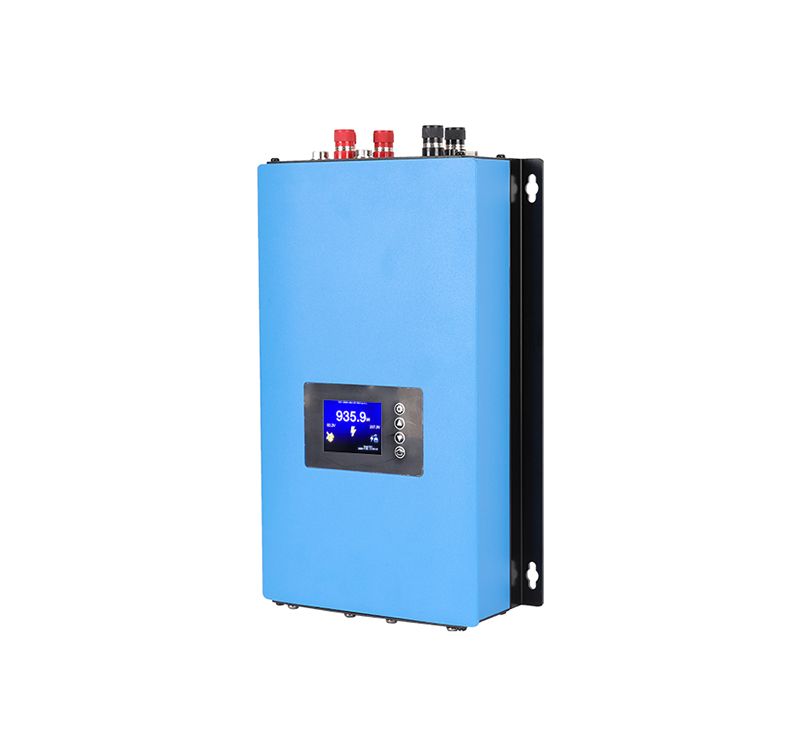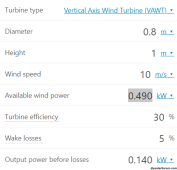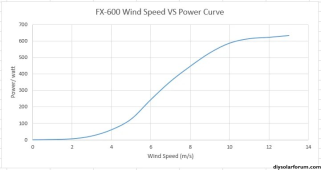Hi all,
Although I don't typically like small wind turbines, I live in a windy place and thought to test one out.
I bought a second hand FX-600 Wind turbine which seems at first to work well.
It is a sturdy unit and I actually believe the 600 Watt can be achieved.

Now, I borrowed one of the (in)famous blue grid-tie wind inverters, in this case the SUN-1000G2-WAL-H, to test it.
The H meaning that the voltage input is from 45 to 90v DC

The FX-600 is rated at 48 volts.
Currently it is only 2 meters above ground, but the wind is right at it, there is just a field next to it, so it gets some good wind.
The goal is to put it up much higher of course.
If I run the FX-600 in the wind without anything connected (so no braking) it actually achieves very high speeds.
I measured the voltage with multimeter (in AC setting) and got voltages such as 75v or even 90v. The 90v was measured at an uncomfortable high speed.
It would be a good voltage to turn on the dump load.
So, at first it seems a good match with the 45v-90v DC input side of the SUN-1000G2-WAL-H. There is also a 22v-65v input version.
However, when connected it doesn't reach the starting voltage. The best it gets is something into the low 40s.
I changed the power curve in the inverter so that the 48v and 52v fields actually ask zero amps, and it starts really light on 56v.
But that didn't have any effect either.
As soon as I disconnect it, it starts to do massive speeds again, very easy.
In other words, that must mean the inverter is putting on too much resistance/load for it get higher, even though it hasn't reached the starting voltage yet?
That seems strange to me.
There is no voltage accross the dumpload, so it isn't (accidentally) enabling the dumpload, and these aren't even enabled in the menu.
It is nicely stopped when I cut the AC power, the wind turbine comes to a halt.
I think the wind turbine is this one (48v version!):
https://www.aliexpress.com/i/33018367542.html
Quite some info, but I don't see any data on where this power curve should be in terms of RPMs and volts?
Should it actually make quite some RPM (and thus voltage) before getting any power?
Or is the 45v input/start limit just to high?
Even if it is high, I would expect it to at least sometimes cross it, generate a bit and then stop.
I am hessitant to just buy the 22v-65v version of this inverter, because they aren't cheap.
And it might not work as well.
The powercurve in meters/second shows the power curve with wind speed, but it would be nice to have those kind of graphs with voltage and RPM as well.
Edit: I read now from my own link that start-up RPM is 250 RPM. So about 4 revs per second.
I haven't been able to measure the RPM, but I think that is already getting close to 40v at that RPM?
I just sticks at around 44v max, and doesn't continue.
I would expect at least a little bit of generation power, since it is getting enough wind to at least make something under 100 Watt
Although I don't typically like small wind turbines, I live in a windy place and thought to test one out.
I bought a second hand FX-600 Wind turbine which seems at first to work well.
It is a sturdy unit and I actually believe the 600 Watt can be achieved.

Now, I borrowed one of the (in)famous blue grid-tie wind inverters, in this case the SUN-1000G2-WAL-H, to test it.
The H meaning that the voltage input is from 45 to 90v DC

The FX-600 is rated at 48 volts.
Currently it is only 2 meters above ground, but the wind is right at it, there is just a field next to it, so it gets some good wind.
The goal is to put it up much higher of course.
If I run the FX-600 in the wind without anything connected (so no braking) it actually achieves very high speeds.
I measured the voltage with multimeter (in AC setting) and got voltages such as 75v or even 90v. The 90v was measured at an uncomfortable high speed.
It would be a good voltage to turn on the dump load.
So, at first it seems a good match with the 45v-90v DC input side of the SUN-1000G2-WAL-H. There is also a 22v-65v input version.
However, when connected it doesn't reach the starting voltage. The best it gets is something into the low 40s.
I changed the power curve in the inverter so that the 48v and 52v fields actually ask zero amps, and it starts really light on 56v.
But that didn't have any effect either.
As soon as I disconnect it, it starts to do massive speeds again, very easy.
In other words, that must mean the inverter is putting on too much resistance/load for it get higher, even though it hasn't reached the starting voltage yet?
That seems strange to me.
There is no voltage accross the dumpload, so it isn't (accidentally) enabling the dumpload, and these aren't even enabled in the menu.
It is nicely stopped when I cut the AC power, the wind turbine comes to a halt.
I think the wind turbine is this one (48v version!):
https://www.aliexpress.com/i/33018367542.html
Quite some info, but I don't see any data on where this power curve should be in terms of RPMs and volts?
Should it actually make quite some RPM (and thus voltage) before getting any power?
Or is the 45v input/start limit just to high?
Even if it is high, I would expect it to at least sometimes cross it, generate a bit and then stop.
I am hessitant to just buy the 22v-65v version of this inverter, because they aren't cheap.
And it might not work as well.
The powercurve in meters/second shows the power curve with wind speed, but it would be nice to have those kind of graphs with voltage and RPM as well.
Edit: I read now from my own link that start-up RPM is 250 RPM. So about 4 revs per second.
I haven't been able to measure the RPM, but I think that is already getting close to 40v at that RPM?
I just sticks at around 44v max, and doesn't continue.
I would expect at least a little bit of generation power, since it is getting enough wind to at least make something under 100 Watt
Last edited:






